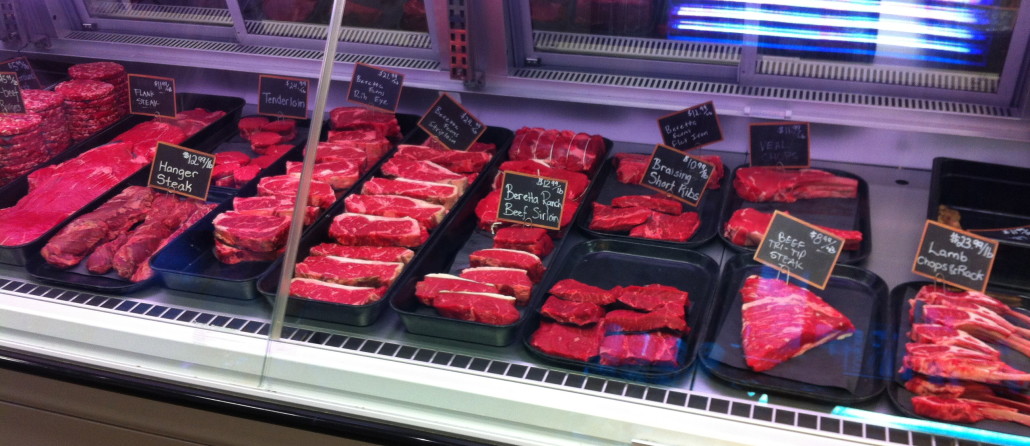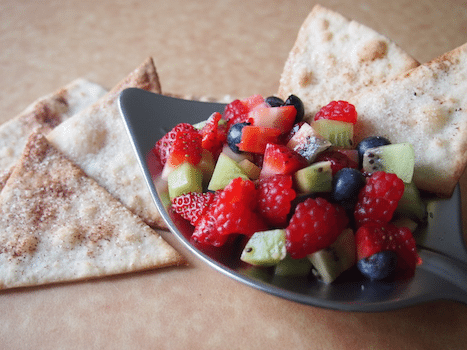Fire up those grills, its barbecue season! Whoo hooo!!! Stuart and I actually got a barbecue this year and we’re excited to use it. What did we do last year? Well we simply used our griddle pan, a perfect alternative if you don’t have a grill.
Now that your barbecue is no longer covered in snow and the weather is getting warmer I’m sure you are all eager to start grilling (we are)! This month in our series: Get Grilling we will provide you with low FODMAP grilling tips, some great barbecue tools and a homemade low FODMAP barbecue sauce recipe. Yes… we know. We are your one-stop-FODMAP-shop! So be sure to check back each week for the next article in the series. Today we start with meat!
Barbecue Basics
Since grilling is a dry-heat cooking method (no moisture is added), we want to use the moist tender cuts of meat to keep our meat from becoming tough and dry. The tenderness of meat is determined by two things:
1. Marbling
Marbling is the amount of fat that runs through a cut of meat (the white streaks). Marbling makes meat juicy, flavourful and tender. In Canada our meat is graded based on the amount of marbling it contains, ranging from Canada A (least amount of marbling) to Canada AAA, and Canada Prime (most amount of marbling). Canada AA and Canada AAA are the most common grades found in grocery stores.
2. Cut
Where the meat comes from on the animal also determines tenderness. Muscles that are used less often are more tender because they have less connective tissue. Some of the most tender beef cuts are:
- Tenderloin
- Rib Eye
- Prime Rib
- Strip Loin
- Rib
- Top Sirloin
These tender cuts tend to be more expensive than less tender cuts like shank, round, chuck (great for burgers, brisket (my fav in stew), and flank (lovely for the grill). If you’re looking for a more cost-effective option, you can use one of these cuts and tenderize using a marinade. Stay tuned for next week where we will talk about marinades and how to prepare them.
When you think about a barbecue, you might only think about cooking common things like burgers or steaks. But it doesn’t end there my friend! The great thing about the barbecue is that you can prepare a variety of delicious and nutritious meals. Some of my favourite things for the grill are whole chicken, salty, brined pork chops, salmon, summer vegetables (amazing in a salad or as a side dish), and of course burgers!
Low FODMAP Grill Guide
For all my tummy-troubled people, always be aware of FODMAPs when grilling. FODMAPs can be hidden in the following foods:
Processed Meats (like sausage, hot dogs, or burgers)
Read the label when picking prepared processed meats as the following ingredients could be hiding in them:
- High fructose corn syrup
- Wheat Ingredients (flour, bread crumbs)
- Milk Solids
- Onion or Garlic Powder
- Honey
BBQ Sauces & Marinades
Again, read the label when picking out a pre-made sauce or marinade as the following ingredients could be hiding in them:
- Onion or Garlic Powder
- Beer
- Flour
- High fructose corn syrup
- Soya Sauce
With an ingredient list full of unfamiliar words, it can be hard to know what will upset your stomach. One way to know for certain your food doesn’t contain any harmful ingredients is to make it simple, using real ingredients at home. Check out this recipe for one of my favourite low FODMAP recipes for the grill – Herb Fennel Chicken Burgers! Also don’t forget to check back next week for a low FODMAP barbecue sauce recipe!

All About Meat
Meat production and consumption is a hot topic with a lot of controversy. Animal treatment, the safety of antibiotics, the negative impact on the environment, and the sustainability of meat production are just a few of the points of debate. The choices you make when it comes to purchasing and consuming meat is in your hands. Personally, I believe that animal protein provides us with many essential nutrients and I choose to include it in my diet. However, I believe we should know where our meat came from so I choose local, naturally-raised and organic as much as possible. I specifically choose grass-fed beef and pasture raised pork. How do you know all this… Just Ask! Find a local butcher or farm you trust.
Here are some of my favourite places to get meat if you are in the Kitchener/Waterloo area:
1. My Butcher the Bauer Butcher. They have grass-fed beef, organic or naturally raised chicken, pasture-raised pork, and are super handy if you have any questions. Tell them Stephanie sent you ;-).
2. Bailey’s Local Foods: great source of 100 mille meat, cheese, and all foodie things!
3. Local Farms! Check out Mapleton’s Organic – it’s a 45 minute drive from Waterloo, you can only buy meat from the farm, but it’s how animals should be raised. You can see all the cow’s hanging out on a summer’s day in the fields. Another cool farm I haven’t visited yet is Banbury Grasslands. They produce high-quality 100% grass-fed beef raised in an environmentally sustainable and friendly manner.
Wherever you live, you have amazing farmers and butchers near you. Simply hunt on google, use an “Eat Local” farm map, or visit your local farmer’s market. Once you are at the market you can talk directly to those farmers. Here are some questions you shouldn’t be afraid to ask:
1. What do you feed your animals? I look for grass fed animals.
2. How are the animals raised? You’re looking for pastured or free-range here.
3. Where is the farm these animals were raised on? Local is better of course!
4. Do you use any antibiotics when caring for your animals? This one is up to you. The choice is treat with antibiotics or kill the animal … it’s a tough one. Talk to your farmer about what they do and why they do it. No judgement here from me 😉
Much love & good eating,
Stephanie

